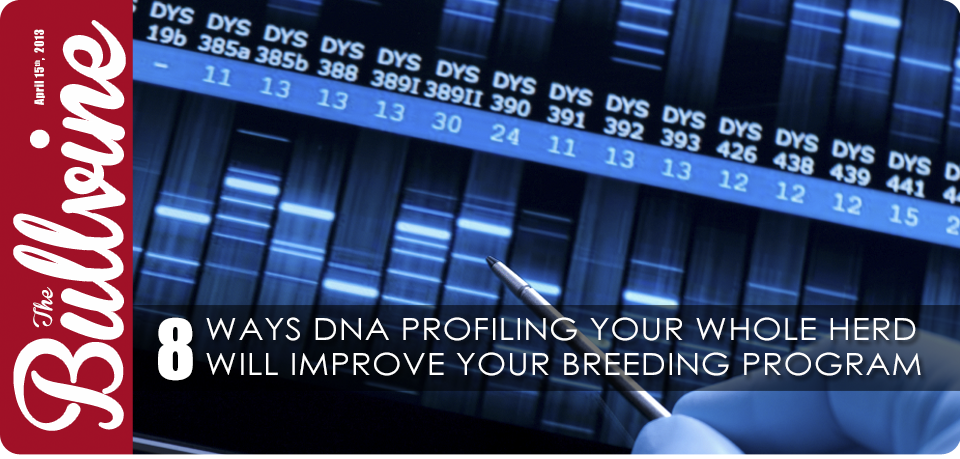DNA profiling is a complimentary tool for the discerning breeder who is committed to genetic advancement for three reasons:
- More accurate genetic selection
- Increased profit
- More effective management
Added to these three is the potential for breed advancement. Therefore, using DNA analysis is definitely a win-win-win situation.
Higher Quality Cattle – Better Genetic Selection
There are already the industry leading early adopters (5%) who quickly recognized the benefits of DNA profiling. Since the dairy industry ranks every animal in the world (Indexes), a new tool that is able to genetically rank every animal in your herd makes sense. The Bullvine has compiled the top 5 ways that DNA analysis can fine tune your selection decisions beyond the elementary keep, cull or sell.
- Identify genetically superior heifers to maximize their value and use for extended reproductive work (ET)
- Identify heifers to cull or use as embryo recipients
- Identify heifers within a cow family that are more likely to be the ones to carry on the family
- Identify AI or natural use sires that will assist in achieving a herd’s genetic plan
- Identify heifers to be sold as herd replacements. As the overall genetics of your herd improves, even lower-end cull heifers will likely make good-quality replacement heifers when sold.
Progress is all about maximizing the potential of every animal. DNA profiling is an identification tool which not only provides the above five points – and perhaps more – but also has three other quick-to-appreciate advantages.
- Provides a jump on genetic information well in advance of a bull being proven
- Provides the best available index values for health and fertility traits
- At the simplest level, provides verification of parentage.
If you’re still hesitating, ask yourself how often a new practice gives you eight ways to advance?
On Farm Profit Could Win by a Hair
Everyone can appreciate the financial incentive of raising the genetic level of your herd. Beyond that there are additional financial incentives from costs saved and revenue generated. The logistics of raising dairy animals is all about efficiently using space and resources. Heifer rearing costs are generally accepted between $2.75 and $3.25 per heifer per day. With DNA analysis at $45 to $60 per animal there is immediate payback. Do the calculations for a 100 cow herd? The revenue from and growing costs saved by selling the lowest four calves will more than pay for the testing of all female calves.
On Farm Management: Better timing – Identified culling
It isn’t only proactive elite breeders who focus on performance and added value. Even those who are most skeptical about trends perk up their ears when positive examples start piling up. Breeders with specific goals relating to high performance, long herd life, or top show type can appreciate a tool that helps accurately identify specific attributes. Furthermore, using DNA analysis to level out the peaks and valleys in freshening rates allows breeders to keep steady numbers in the calf hutches and heifer pens. More accurately identifying your own cattle makes it that much easier to market them to the specific needs of buyers. The genomic numbers become part of promoting animals in ads, social media and in the barn. Not only is it a genetic tool but a full-disclosure marketing tool, when the information is available to all buying and selling scenarios.
Industry Advancement: Pedigree accuracy – Breed purity
Much like requiring RFID tags for all animals, a DNA profile has the potential to add much to the breeding stock industry
– Will assist in improving low heritability traits: health and fertility
– Allows for a breed society to require that all males registered be DNA profiled
– Allows for a breeding company to require that all daughters in a sire’s proof be DNA profiled and parentage verified
– As more herds sample their females for genomics, expect the technology to become more accurate and cost-efficient
How & When – Determine Your Strategy
There is not one procedure or process that will work for all herds. Determine the simplest, most accurate steps available to you. The suggested best practice is testing every heifer calf at one day of age or by 30 days of age. Determine how the following choices could work for you.
– DNA profile as close to registration as possible. The sooner the better.
– Chose which panel. Low density unless for bulls for AI or top heifers to be sold
– Even if a breeder may not practice ET, the top 15% should be bred to the highest genomic sires for total index, type, production or health and fertility.
– The middle range should be bred using sexed semen
– The bottom 10% could be sold as embryo transfer recipients or bred to beef semen
Question for Breed Associations to Ponder
Is it in fact a good long term strategy to have DNA analysis remain optional or should it be mandatory some time in the future? __Optional? __Mandatory?
The Bullvine Bottom Line
DNA Profiling will allow the vast majority of breeders to sort, select and sell females according to their personal herd strategies and mate retained heifers for more rapid genetic progress. The benefits to individual breeders and the Holstein breed as a whole will be measureable. What are you waiting for?
Not sure what all this hype about genomics is all about?
Want to learn what it is and what it means to your breeding program?


















Leave a Reply
You must be logged in to post a comment.